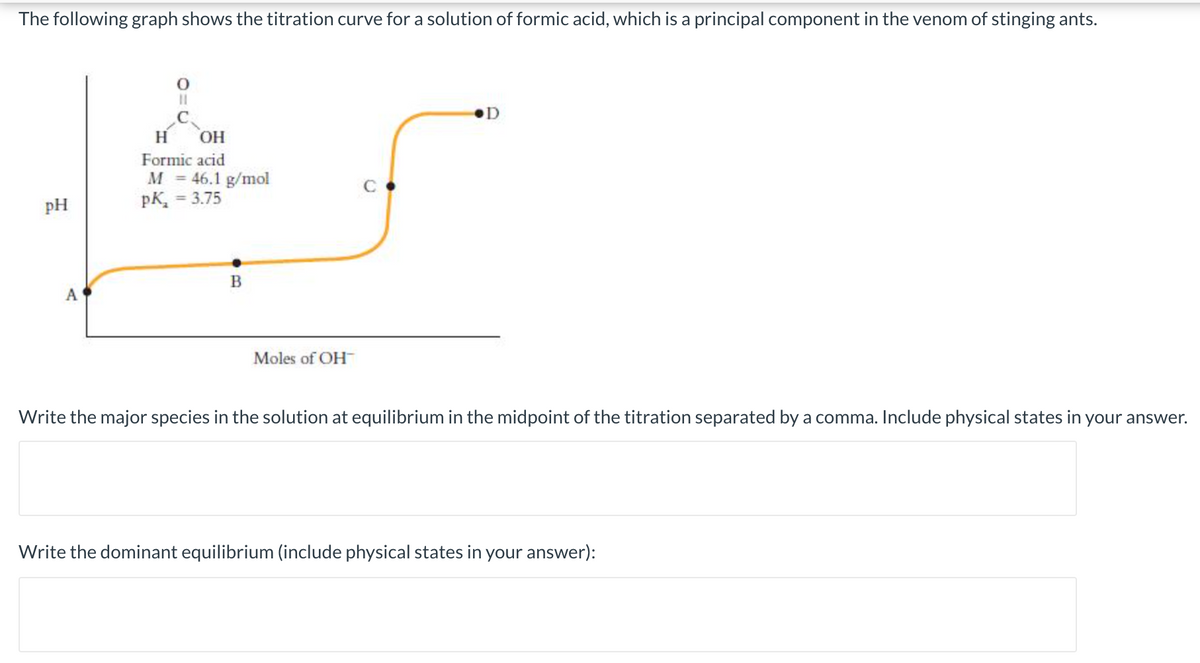The following graph shows the titration curve for a solution of formic acid, which is a principal component in the venom of stinging ants. D H OH Formic acid M = 46.1 g/mol pK, = 3.75 pH B A Moles of OH Write the major species in the solution at equilibrium in the midpoint of the titration separated by a comma. Include physical states in your answer. Write the dominant equilibrium (include physical states in your answer):
The following graph shows the titration curve for a solution of formic acid, which is a principal component in the venom of stinging ants. D H OH Formic acid M = 46.1 g/mol pK, = 3.75 pH B A Moles of OH Write the major species in the solution at equilibrium in the midpoint of the titration separated by a comma. Include physical states in your answer. Write the dominant equilibrium (include physical states in your answer):
Chemistry & Chemical Reactivity
9th Edition
ISBN:9781133949640
Author:John C. Kotz, Paul M. Treichel, John Townsend, David Treichel
Publisher:John C. Kotz, Paul M. Treichel, John Townsend, David Treichel
Chapter15: Principles Of Chemical Reactivity: Equilibria
Section: Chapter Questions
Problem 15PS: The equilibrium constant for the dissociation of iodine molecules to iodine atoms I2(g) 2 I(g) is...
Related questions
Question
QUESTION 3.
This is one whole question so please answer it correctly

Transcribed Image Text:The following graph shows the titration curve for a solution of formic acid, which is a principal component in the venom of stinging ants.
н он
Formic acid
M = 46.1 g/mol
pK, = 3.75
pH
A
Moles of OH
Write the major species in the solution at equilibrium in the midpoint of the titration separated by a comma. Include physical states in your answer.
Write the dominant equilibrium (include physical states in your answer):
![Write the equilibrium constant expression for points B, C, and D. Fill the missing powers in the following expressions. In case of first order type "1".
For point B:
K = [HCO0 ]H,0*[HCOOH]
a
For point C:
K = [HCOO-]H[OH¯]H[HCOOH]!
a
For point D:
K = [HCOO ]H[OH¯][HCOOH]!
a](/v2/_next/image?url=https%3A%2F%2Fcontent.bartleby.com%2Fqna-images%2Fquestion%2F22d60ceb-98cb-402e-9eae-2a04face0749%2F18530ac7-7f47-466d-aaa8-9f049deb5a4a%2Fns0qswd_processed.png&w=3840&q=75)
Transcribed Image Text:Write the equilibrium constant expression for points B, C, and D. Fill the missing powers in the following expressions. In case of first order type "1".
For point B:
K = [HCO0 ]H,0*[HCOOH]
a
For point C:
K = [HCOO-]H[OH¯]H[HCOOH]!
a
For point D:
K = [HCOO ]H[OH¯][HCOOH]!
a
Expert Solution
This question has been solved!
Explore an expertly crafted, step-by-step solution for a thorough understanding of key concepts.
Step by step
Solved in 5 steps

Knowledge Booster
Learn more about
Need a deep-dive on the concept behind this application? Look no further. Learn more about this topic, chemistry and related others by exploring similar questions and additional content below.Recommended textbooks for you

Chemistry & Chemical Reactivity
Chemistry
ISBN:
9781133949640
Author:
John C. Kotz, Paul M. Treichel, John Townsend, David Treichel
Publisher:
Cengage Learning

Chemistry & Chemical Reactivity
Chemistry
ISBN:
9781337399074
Author:
John C. Kotz, Paul M. Treichel, John Townsend, David Treichel
Publisher:
Cengage Learning

Chemistry: The Molecular Science
Chemistry
ISBN:
9781285199047
Author:
John W. Moore, Conrad L. Stanitski
Publisher:
Cengage Learning

Chemistry & Chemical Reactivity
Chemistry
ISBN:
9781133949640
Author:
John C. Kotz, Paul M. Treichel, John Townsend, David Treichel
Publisher:
Cengage Learning

Chemistry & Chemical Reactivity
Chemistry
ISBN:
9781337399074
Author:
John C. Kotz, Paul M. Treichel, John Townsend, David Treichel
Publisher:
Cengage Learning

Chemistry: The Molecular Science
Chemistry
ISBN:
9781285199047
Author:
John W. Moore, Conrad L. Stanitski
Publisher:
Cengage Learning

Introductory Chemistry: An Active Learning Approa…
Chemistry
ISBN:
9781305079250
Author:
Mark S. Cracolice, Ed Peters
Publisher:
Cengage Learning

Introductory Chemistry: A Foundation
Chemistry
ISBN:
9781337399425
Author:
Steven S. Zumdahl, Donald J. DeCoste
Publisher:
Cengage Learning

Chemistry by OpenStax (2015-05-04)
Chemistry
ISBN:
9781938168390
Author:
Klaus Theopold, Richard H Langley, Paul Flowers, William R. Robinson, Mark Blaser
Publisher:
OpenStax